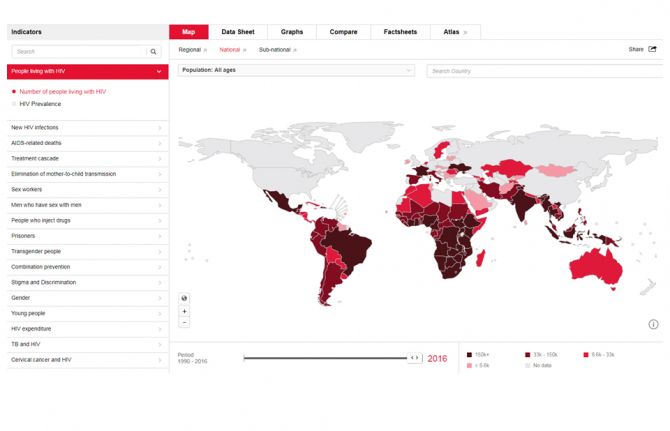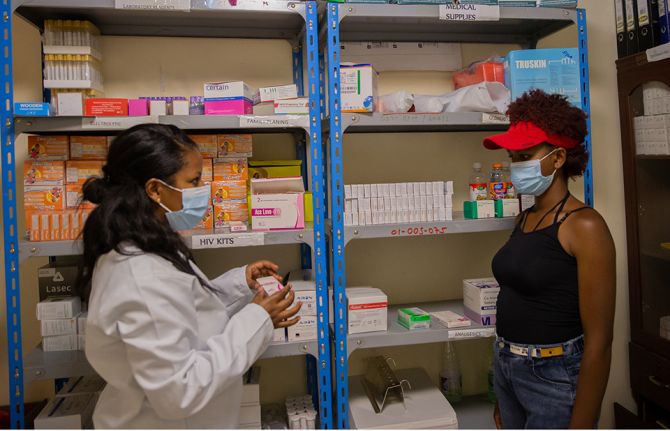

Feature Story
Checking HIV data at every step
22 March 2018
22 March 2018 22 March 2018No disease has the same level of timely and accurate data collection, analysis and distribution as HIV. With credible and up-to-date data, countries and the international community can plan effective AIDS responses. They can focus services on the locations and populations that most need them, increasing impact and decreasing costs.
The responsibility for producing what is acknowledged to be the gold standard information on the global HIV epidemic rests with UNAIDS. For the information to be useful, though, it must be credible. And to be credible, it must be collected properly, thoroughly checked and proven to be accurate.
All HIV-related estimates published by UNAIDS are based on data collected in the countries and communities where the people who are living with and affected by HIV reside. In each country, teams of experts—epidemiologists, demographers, monitoring and evaluation specialists and others—use UNAIDS-supported software called Spectrum once a year to make estimates of the number of people living with HIV, the number of new HIV infections, the number of AIDS-related deaths, the coverage of antiretroviral therapy, etc. The data files produced by the software in the countries are then sent to UNAIDS.
How the data are estimated depends on the nature of the HIV epidemic in the country. In countries where HIV has spread to the general population, data are obtained from pregnant women attending antenatal clinics. In the past, only a sample of pregnant women who went to one of a network of clinics would be tested for HIV as part of surveillance efforts. Increasingly, however, countries have moved to using programmatic data about the level of HIV infection among all pregnant women tested at health facilities. These data, combined with data from nationally representative population-based surveys—which have broader coverage and include men, but are conducted less frequently—are used in the model, together with a set of assumptions, to calculate HIV prevalence, HIV incidence, AIDS-related deaths, the coverage of antiretroviral therapy and more.
Other countries have low-level HIV epidemics. If HIV transmission occurs mainly among key populations (people who inject drugs, sex workers, gay men and other men who have sex with men, transgender people and prisoners), data from HIV prevalence studies—which are usually focused on key populations—are most often used to calculate national estimates and trends. Estimates of the size of key populations are being calculated in more and more countries. If studies are not available, estimates are made based on data from the local region and with agreement among experts. Other sources of data—including population-based surveys and testing of pregnant women—are used to estimate HIV prevalence among the general population. HIV prevalence and the number of people on antiretroviral therapy are then used to derive national HIV trends. An increasing number of countries are using the number of deduplicated HIV case reports to estimate HIV incidence.
UNAIDS doesn’t just take data from countries uncritically and publish, though. The files submitted by the countries are reviewed by UNAIDS to ensure that the results are comparable across regions and countries and over time.
There is also ongoing validation of the Spectrum outputs with other data to check how accurately the estimates match with reality. For example, researchers compared Spectrum data with data on women attending antenatal clinics, census data and population survey data from a study in Manicaland, Zimbabwe. The Spectrum estimates of HIV incidence and prevalence were found to be generally in good agreement with the data, although some discrepancies were found.
In 2016, UNAIDS compared the quantities of medicines exported by generic medicine producers and found those to be broadly similar to programmatic reports of medicine usage and stocks in countries. Also, the recent Population-Based HIV Impact Assessments surveys allow a comparison of the coverage of antiretroviral treatment, as they collect self-reported adherence to antiretroviral therapy and also aim to measure the presence of antiretroviral medicines directly in blood samples. In many countries, the resulting coverage confirms the coverage reported by programmatic data—where results don’t seem to concur, further investigations at the facility level are undertaken. Such research and triangulations help to make data more precise and refine the Spectrum model.
How well estimates on access to antiretroviral medicines agree can be seen in the two graphs on HIV treatment in South Africa. The first shows how close the procurement data for antiretroviral medicines match the number of people reported to be accessing the medicines. The second shows how the UNAIDS estimate of the percentage of people living with HIV accessing HIV treatment agrees with the percentage estimated by the South Africa Human Sciences Research Council in 2012.
There are several situations in which UNAIDS won’t publish data, because of uncertainty around the quality of the information. For example, UNAIDS does not give estimates in some countries that have concentrated epidemics of mother-to-child transmission of HIV and of the number of children living with HIV unless there is proper supporting evidence. Where historical data can’t back up trends in HIV incidence, UNAIDS doesn’t publish the past data. And UNAIDS also doesn’t publish country estimates if further data or analyses are needed to produce valid estimates.
The integrity of UNAIDS data is also ensured through an annual update of the Spectrum model. The model is refined as new data become available, such as updated information on the probabilities of mother-to-child transmission of HIV, the age at which children start antiretroviral therapy, age and sex patterns of HIV infection, the effectiveness of antiretroviral therapy in reducing mortality and incidence, etc. These changes in the model can, however, lead to changes in estimates for both the current year and past years, resulting in the need to issue a full new set of historical data each year.
By continually refining the data collection and validation process, UNAIDS is making sure that the data it publishes continue to be valued and respected by the people and organizations that are working towards ending AIDS by 2030.



